Microeconomics: Examining Real-World Product Markets and Concepts
VerifiedAdded on 2023/06/12
|16
|2415
|375
Report
AI Summary
This report provides a comprehensive analysis of real-world product market scenarios using fundamental microeconomic concepts. It examines the energy sector in Australia through the lens of the production possibility frontier, the coffee market in Dubai to illustrate demand and supply dynamics, the housing market in Sydney to explore market equilibrium, the impact of taxes on tobacco in Egypt to demonstrate inelastic demand, and the effects of transportation in Australia to discuss utility. The analysis demonstrates the close relationship between economic concepts and real-world market activities, highlighting how each facet of the product industry can be understood through microeconomic principles. The report concludes that these concepts are crucial for understanding and interpreting real-world economic phenomena.
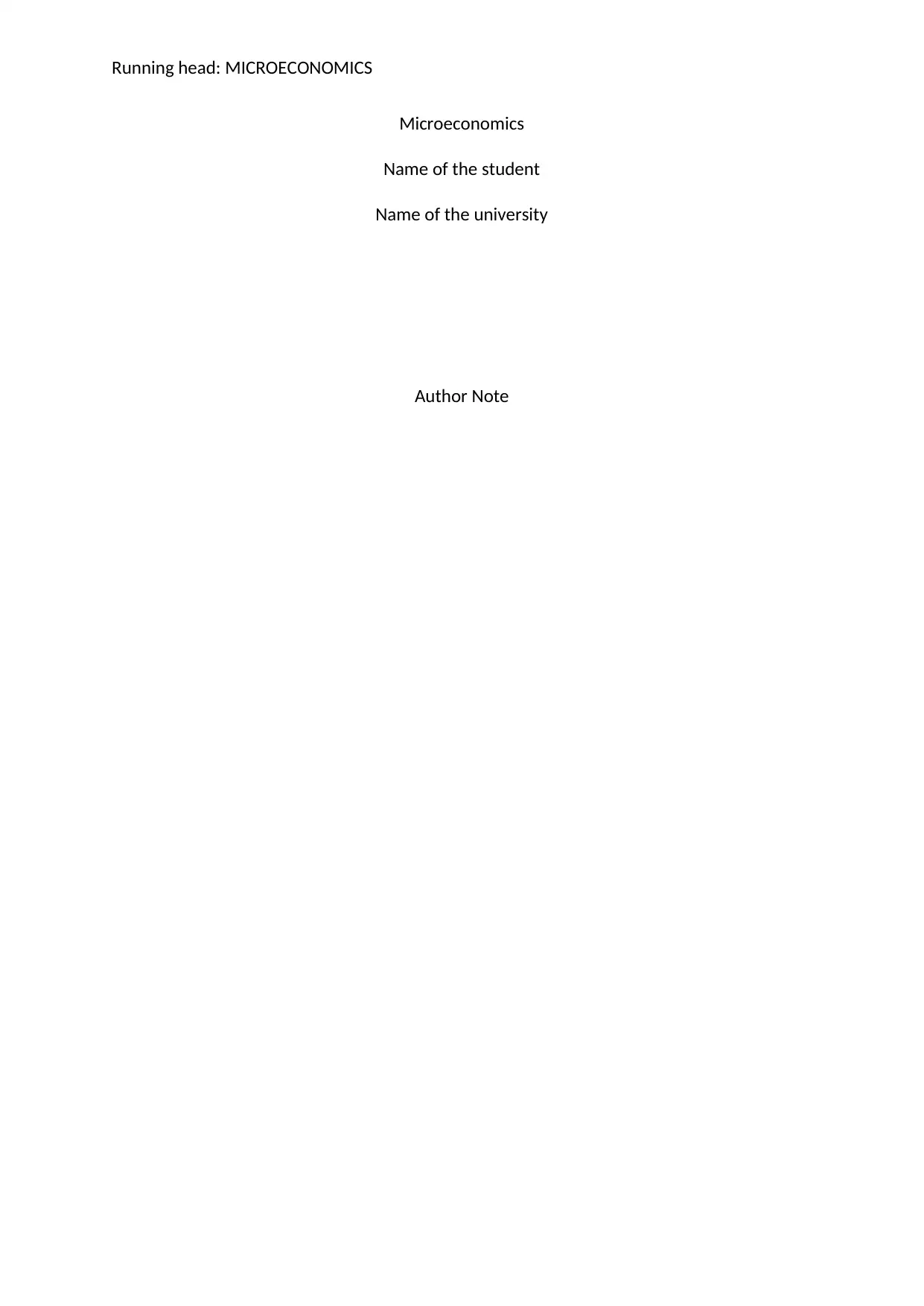
Running head: MICROECONOMICS
Microeconomics
Name of the student
Name of the university
Author Note
Microeconomics
Name of the student
Name of the university
Author Note
Paraphrase This Document
Need a fresh take? Get an instant paraphrase of this document with our AI Paraphraser

1MICROECONOMICS
Table of Contents
Introduction:..............................................................................................................................2
2. Analysis...................................................................................................................................3
2.1 Analysis 1:.........................................................................................................................3
(Topic: Production possibility frontier and the opportunity cost).........................................3
2.2 Analysis 2:.........................................................................................................................5
(Topic: Demand and supply)..................................................................................................5
2.3 Analysis 3:.........................................................................................................................7
(Topic: Market equilibrium)...................................................................................................7
2.4 Analysis 4:.............................................................................................................................9
(Topic: Inelastic demand and increased total revenue)........................................................9
2.5 Analysis 5:.......................................................................................................................11
(Topic: Utility).......................................................................................................................11
Conclusion:...............................................................................................................................13
References:...............................................................................................................................14
Table of Contents
Introduction:..............................................................................................................................2
2. Analysis...................................................................................................................................3
2.1 Analysis 1:.........................................................................................................................3
(Topic: Production possibility frontier and the opportunity cost).........................................3
2.2 Analysis 2:.........................................................................................................................5
(Topic: Demand and supply)..................................................................................................5
2.3 Analysis 3:.........................................................................................................................7
(Topic: Market equilibrium)...................................................................................................7
2.4 Analysis 4:.............................................................................................................................9
(Topic: Inelastic demand and increased total revenue)........................................................9
2.5 Analysis 5:.......................................................................................................................11
(Topic: Utility).......................................................................................................................11
Conclusion:...............................................................................................................................13
References:...............................................................................................................................14
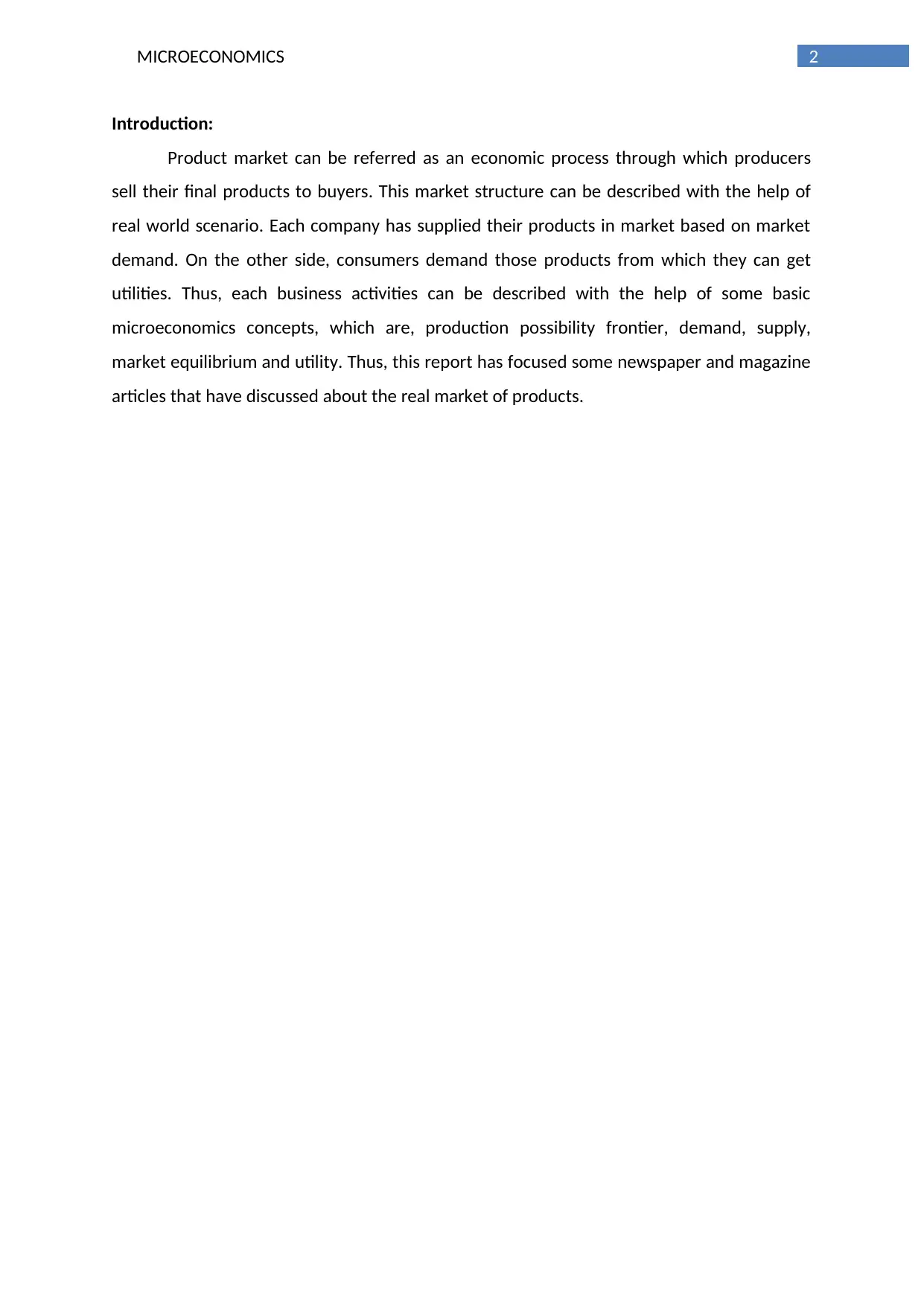
2MICROECONOMICS
Introduction:
Product market can be referred as an economic process through which producers
sell their final products to buyers. This market structure can be described with the help of
real world scenario. Each company has supplied their products in market based on market
demand. On the other side, consumers demand those products from which they can get
utilities. Thus, each business activities can be described with the help of some basic
microeconomics concepts, which are, production possibility frontier, demand, supply,
market equilibrium and utility. Thus, this report has focused some newspaper and magazine
articles that have discussed about the real market of products.
Introduction:
Product market can be referred as an economic process through which producers
sell their final products to buyers. This market structure can be described with the help of
real world scenario. Each company has supplied their products in market based on market
demand. On the other side, consumers demand those products from which they can get
utilities. Thus, each business activities can be described with the help of some basic
microeconomics concepts, which are, production possibility frontier, demand, supply,
market equilibrium and utility. Thus, this report has focused some newspaper and magazine
articles that have discussed about the real market of products.
⊘ This is a preview!⊘
Do you want full access?
Subscribe today to unlock all pages.

Trusted by 1+ million students worldwide
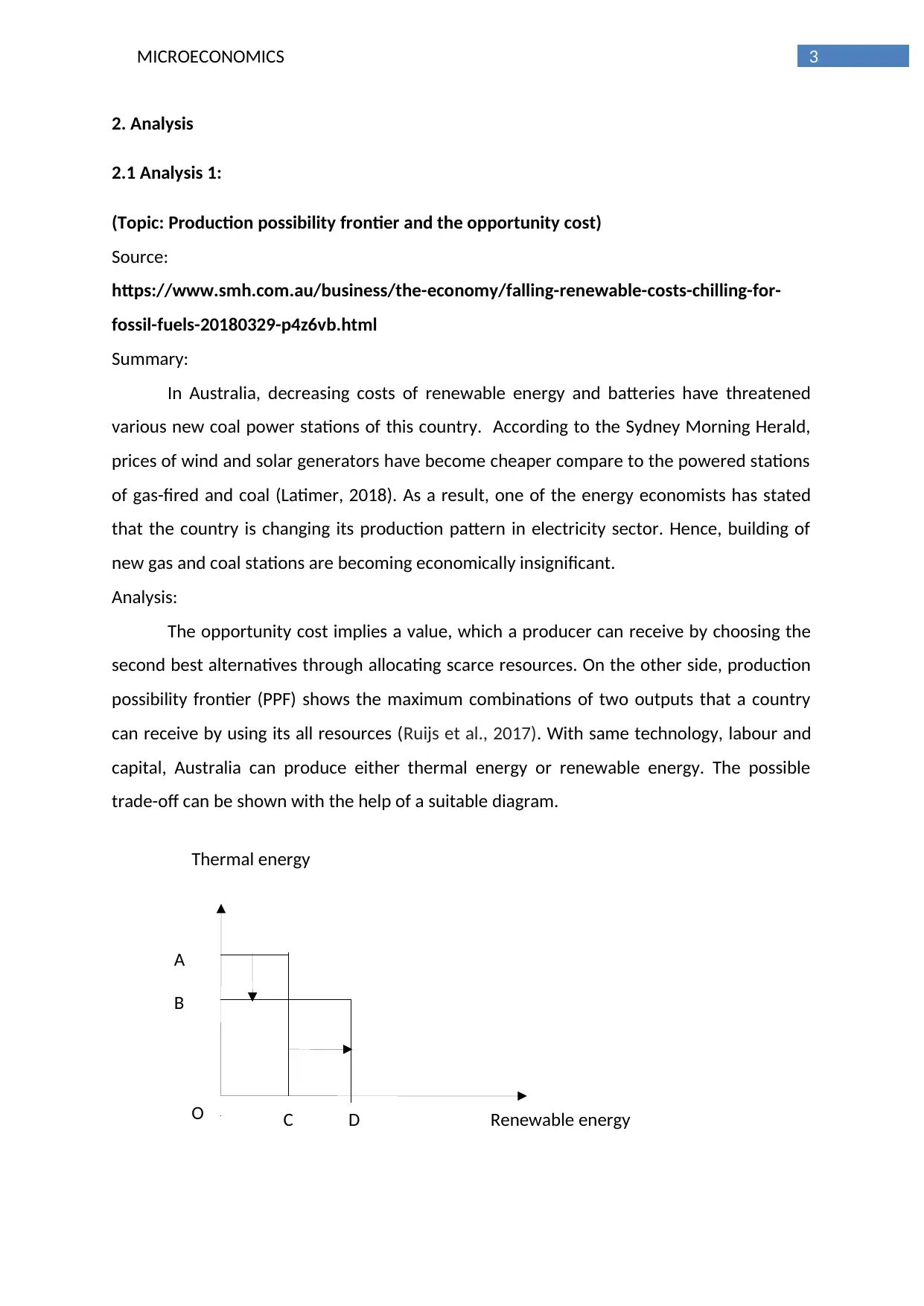
Thermal energy
Renewable energyO
A
B
C D
3MICROECONOMICS
2. Analysis
2.1 Analysis 1:
(Topic: Production possibility frontier and the opportunity cost)
Source:
https://www.smh.com.au/business/the-economy/falling-renewable-costs-chilling-for-
fossil-fuels-20180329-p4z6vb.html
Summary:
In Australia, decreasing costs of renewable energy and batteries have threatened
various new coal power stations of this country. According to the Sydney Morning Herald,
prices of wind and solar generators have become cheaper compare to the powered stations
of gas-fired and coal (Latimer, 2018). As a result, one of the energy economists has stated
that the country is changing its production pattern in electricity sector. Hence, building of
new gas and coal stations are becoming economically insignificant.
Analysis:
The opportunity cost implies a value, which a producer can receive by choosing the
second best alternatives through allocating scarce resources. On the other side, production
possibility frontier (PPF) shows the maximum combinations of two outputs that a country
can receive by using its all resources (Ruijs et al., 2017). With same technology, labour and
capital, Australia can produce either thermal energy or renewable energy. The possible
trade-off can be shown with the help of a suitable diagram.
Renewable energyO
A
B
C D
3MICROECONOMICS
2. Analysis
2.1 Analysis 1:
(Topic: Production possibility frontier and the opportunity cost)
Source:
https://www.smh.com.au/business/the-economy/falling-renewable-costs-chilling-for-
fossil-fuels-20180329-p4z6vb.html
Summary:
In Australia, decreasing costs of renewable energy and batteries have threatened
various new coal power stations of this country. According to the Sydney Morning Herald,
prices of wind and solar generators have become cheaper compare to the powered stations
of gas-fired and coal (Latimer, 2018). As a result, one of the energy economists has stated
that the country is changing its production pattern in electricity sector. Hence, building of
new gas and coal stations are becoming economically insignificant.
Analysis:
The opportunity cost implies a value, which a producer can receive by choosing the
second best alternatives through allocating scarce resources. On the other side, production
possibility frontier (PPF) shows the maximum combinations of two outputs that a country
can receive by using its all resources (Ruijs et al., 2017). With same technology, labour and
capital, Australia can produce either thermal energy or renewable energy. The possible
trade-off can be shown with the help of a suitable diagram.
Paraphrase This Document
Need a fresh take? Get an instant paraphrase of this document with our AI Paraphraser
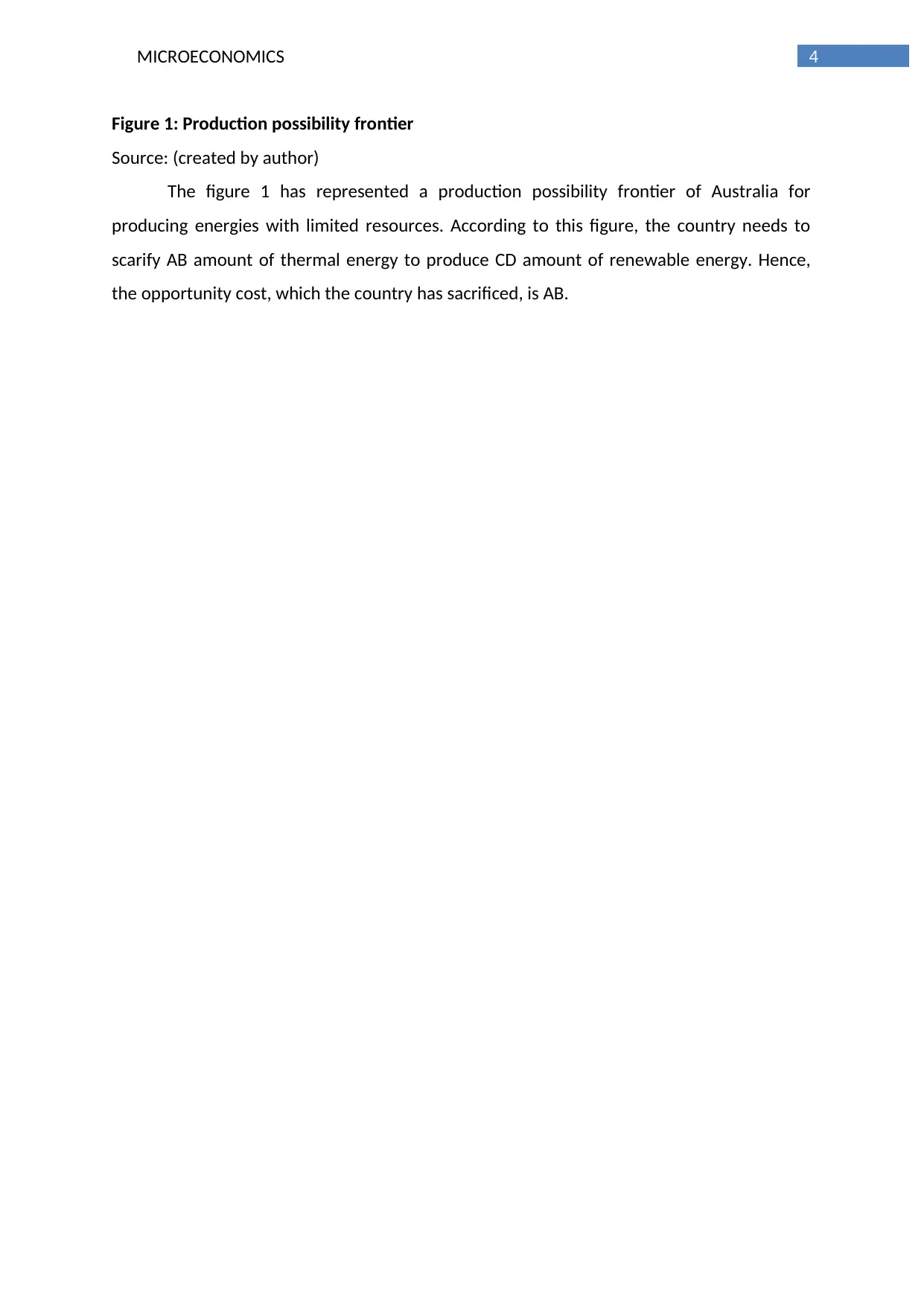
4MICROECONOMICS
Figure 1: Production possibility frontier
Source: (created by author)
The figure 1 has represented a production possibility frontier of Australia for
producing energies with limited resources. According to this figure, the country needs to
scarify AB amount of thermal energy to produce CD amount of renewable energy. Hence,
the opportunity cost, which the country has sacrificed, is AB.
Figure 1: Production possibility frontier
Source: (created by author)
The figure 1 has represented a production possibility frontier of Australia for
producing energies with limited resources. According to this figure, the country needs to
scarify AB amount of thermal energy to produce CD amount of renewable energy. Hence,
the opportunity cost, which the country has sacrificed, is AB.
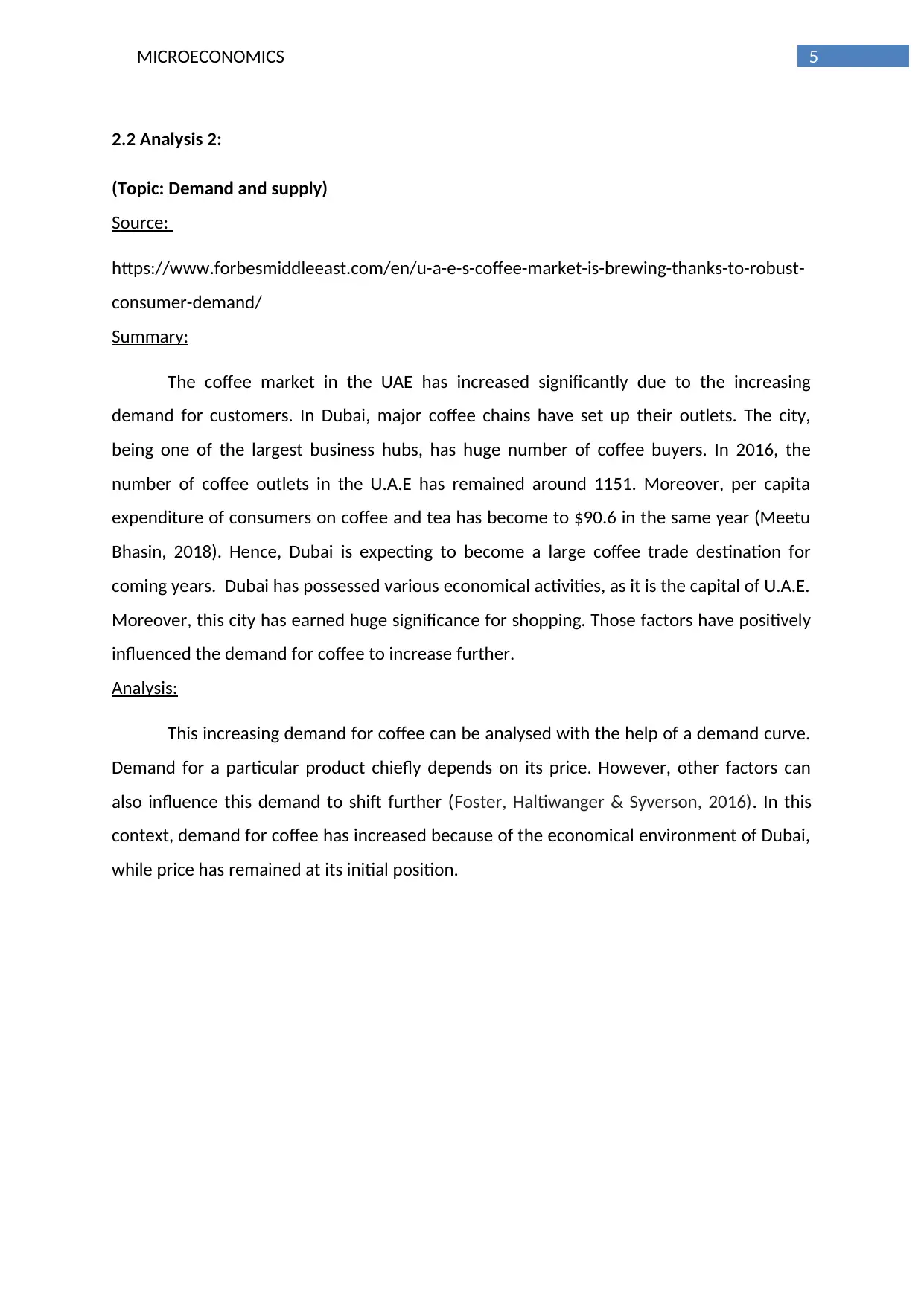
5MICROECONOMICS
2.2 Analysis 2:
(Topic: Demand and supply)
Source:
https://www.forbesmiddleeast.com/en/u-a-e-s-coffee-market-is-brewing-thanks-to-robust-
consumer-demand/
Summary:
The coffee market in the UAE has increased significantly due to the increasing
demand for customers. In Dubai, major coffee chains have set up their outlets. The city,
being one of the largest business hubs, has huge number of coffee buyers. In 2016, the
number of coffee outlets in the U.A.E has remained around 1151. Moreover, per capita
expenditure of consumers on coffee and tea has become to $90.6 in the same year (Meetu
Bhasin, 2018). Hence, Dubai is expecting to become a large coffee trade destination for
coming years. Dubai has possessed various economical activities, as it is the capital of U.A.E.
Moreover, this city has earned huge significance for shopping. Those factors have positively
influenced the demand for coffee to increase further.
Analysis:
This increasing demand for coffee can be analysed with the help of a demand curve.
Demand for a particular product chiefly depends on its price. However, other factors can
also influence this demand to shift further (Foster, Haltiwanger & Syverson, 2016). In this
context, demand for coffee has increased because of the economical environment of Dubai,
while price has remained at its initial position.
2.2 Analysis 2:
(Topic: Demand and supply)
Source:
https://www.forbesmiddleeast.com/en/u-a-e-s-coffee-market-is-brewing-thanks-to-robust-
consumer-demand/
Summary:
The coffee market in the UAE has increased significantly due to the increasing
demand for customers. In Dubai, major coffee chains have set up their outlets. The city,
being one of the largest business hubs, has huge number of coffee buyers. In 2016, the
number of coffee outlets in the U.A.E has remained around 1151. Moreover, per capita
expenditure of consumers on coffee and tea has become to $90.6 in the same year (Meetu
Bhasin, 2018). Hence, Dubai is expecting to become a large coffee trade destination for
coming years. Dubai has possessed various economical activities, as it is the capital of U.A.E.
Moreover, this city has earned huge significance for shopping. Those factors have positively
influenced the demand for coffee to increase further.
Analysis:
This increasing demand for coffee can be analysed with the help of a demand curve.
Demand for a particular product chiefly depends on its price. However, other factors can
also influence this demand to shift further (Foster, Haltiwanger & Syverson, 2016). In this
context, demand for coffee has increased because of the economical environment of Dubai,
while price has remained at its initial position.
⊘ This is a preview!⊘
Do you want full access?
Subscribe today to unlock all pages.

Trusted by 1+ million students worldwide
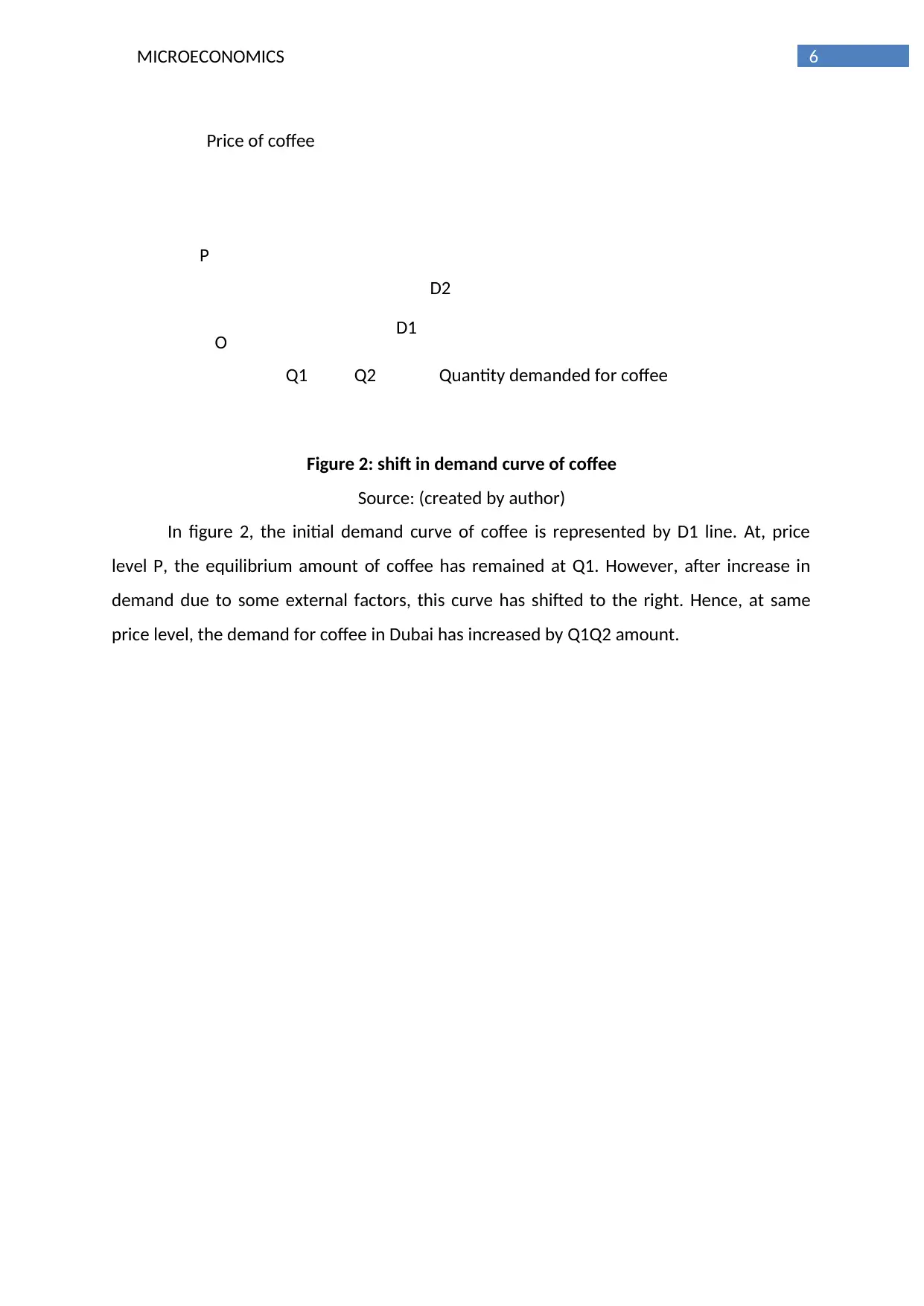
6MICROECONOMICS
Price of coffee
Quantity demanded for coffee
O
P
Q1 Q2
D1
D2
Figure 2: shift in demand curve of coffee
Source: (created by author)
In figure 2, the initial demand curve of coffee is represented by D1 line. At, price
level P, the equilibrium amount of coffee has remained at Q1. However, after increase in
demand due to some external factors, this curve has shifted to the right. Hence, at same
price level, the demand for coffee in Dubai has increased by Q1Q2 amount.
Price of coffee
Quantity demanded for coffee
O
P
Q1 Q2
D1
D2
Figure 2: shift in demand curve of coffee
Source: (created by author)
In figure 2, the initial demand curve of coffee is represented by D1 line. At, price
level P, the equilibrium amount of coffee has remained at Q1. However, after increase in
demand due to some external factors, this curve has shifted to the right. Hence, at same
price level, the demand for coffee in Dubai has increased by Q1Q2 amount.
Paraphrase This Document
Need a fresh take? Get an instant paraphrase of this document with our AI Paraphraser
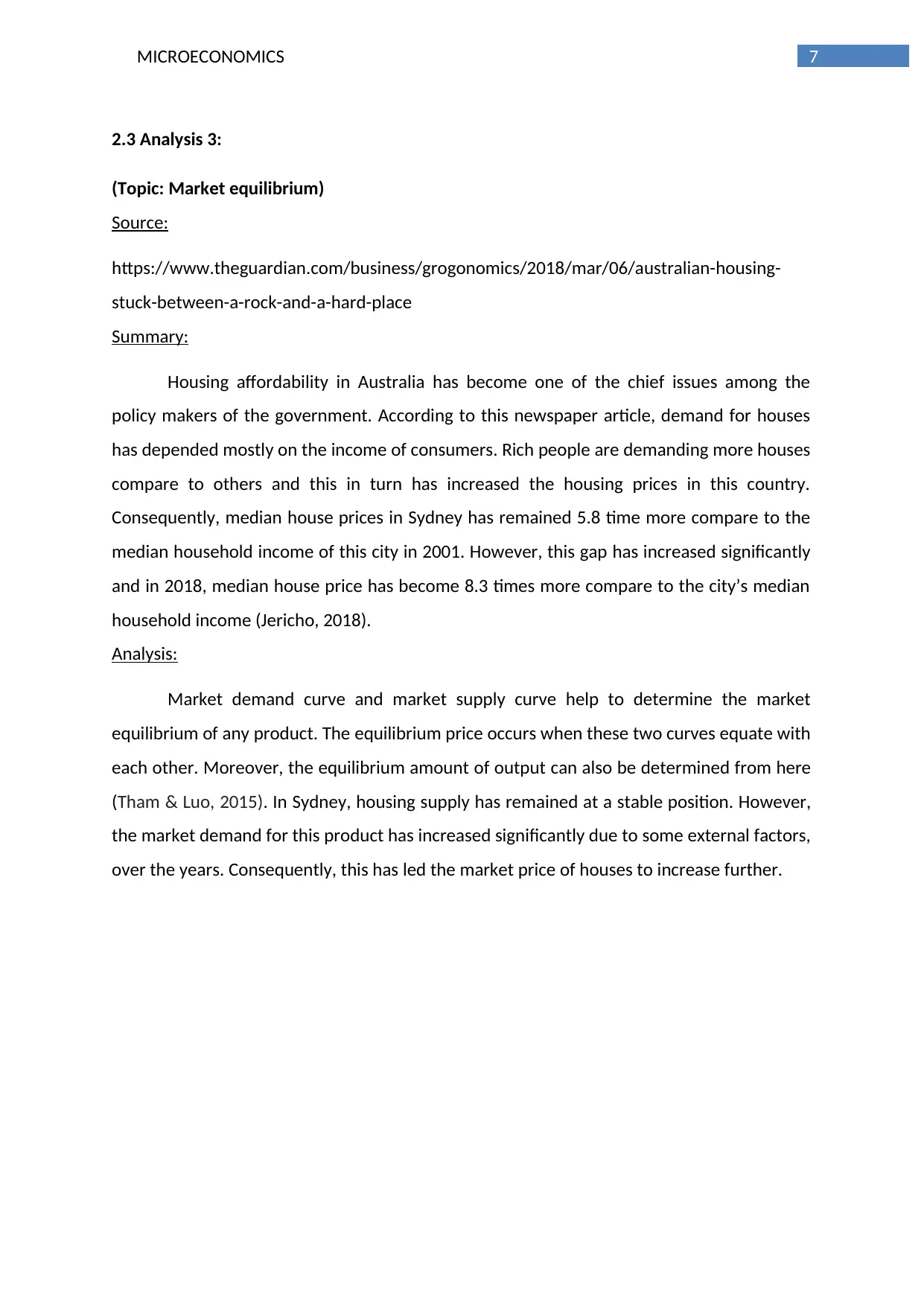
7MICROECONOMICS
2.3 Analysis 3:
(Topic: Market equilibrium)
Source:
https://www.theguardian.com/business/grogonomics/2018/mar/06/australian-housing-
stuck-between-a-rock-and-a-hard-place
Summary:
Housing affordability in Australia has become one of the chief issues among the
policy makers of the government. According to this newspaper article, demand for houses
has depended mostly on the income of consumers. Rich people are demanding more houses
compare to others and this in turn has increased the housing prices in this country.
Consequently, median house prices in Sydney has remained 5.8 time more compare to the
median household income of this city in 2001. However, this gap has increased significantly
and in 2018, median house price has become 8.3 times more compare to the city’s median
household income (Jericho, 2018).
Analysis:
Market demand curve and market supply curve help to determine the market
equilibrium of any product. The equilibrium price occurs when these two curves equate with
each other. Moreover, the equilibrium amount of output can also be determined from here
(Tham & Luo, 2015). In Sydney, housing supply has remained at a stable position. However,
the market demand for this product has increased significantly due to some external factors,
over the years. Consequently, this has led the market price of houses to increase further.
2.3 Analysis 3:
(Topic: Market equilibrium)
Source:
https://www.theguardian.com/business/grogonomics/2018/mar/06/australian-housing-
stuck-between-a-rock-and-a-hard-place
Summary:
Housing affordability in Australia has become one of the chief issues among the
policy makers of the government. According to this newspaper article, demand for houses
has depended mostly on the income of consumers. Rich people are demanding more houses
compare to others and this in turn has increased the housing prices in this country.
Consequently, median house prices in Sydney has remained 5.8 time more compare to the
median household income of this city in 2001. However, this gap has increased significantly
and in 2018, median house price has become 8.3 times more compare to the city’s median
household income (Jericho, 2018).
Analysis:
Market demand curve and market supply curve help to determine the market
equilibrium of any product. The equilibrium price occurs when these two curves equate with
each other. Moreover, the equilibrium amount of output can also be determined from here
(Tham & Luo, 2015). In Sydney, housing supply has remained at a stable position. However,
the market demand for this product has increased significantly due to some external factors,
over the years. Consequently, this has led the market price of houses to increase further.

8MICROECONOMICS
O
P1
P0
Q0 Q1
D0
D1
S
Amount of houses
Figure 3: Market equilibrium of houses in Sydney
Source: (created by author)
According to figure 3, the initial demand curve of houses is D0 while the stable
supply curve is S. At this situation, the housing price in Sydney has remained at P1 and the
corresponding quantity demanded has remained at Q0. After increase in demand for
houses, the new demand curve has become D1 while supply has remained at its initial level.
At this situation, the market price of houses has increased by P0P1 unit for extra Q0Q1
amount of houses.
Housing prices
O
P1
P0
Q0 Q1
D0
D1
S
Amount of houses
Figure 3: Market equilibrium of houses in Sydney
Source: (created by author)
According to figure 3, the initial demand curve of houses is D0 while the stable
supply curve is S. At this situation, the housing price in Sydney has remained at P1 and the
corresponding quantity demanded has remained at Q0. After increase in demand for
houses, the new demand curve has become D1 while supply has remained at its initial level.
At this situation, the market price of houses has increased by P0P1 unit for extra Q0Q1
amount of houses.
Housing prices
⊘ This is a preview!⊘
Do you want full access?
Subscribe today to unlock all pages.

Trusted by 1+ million students worldwide
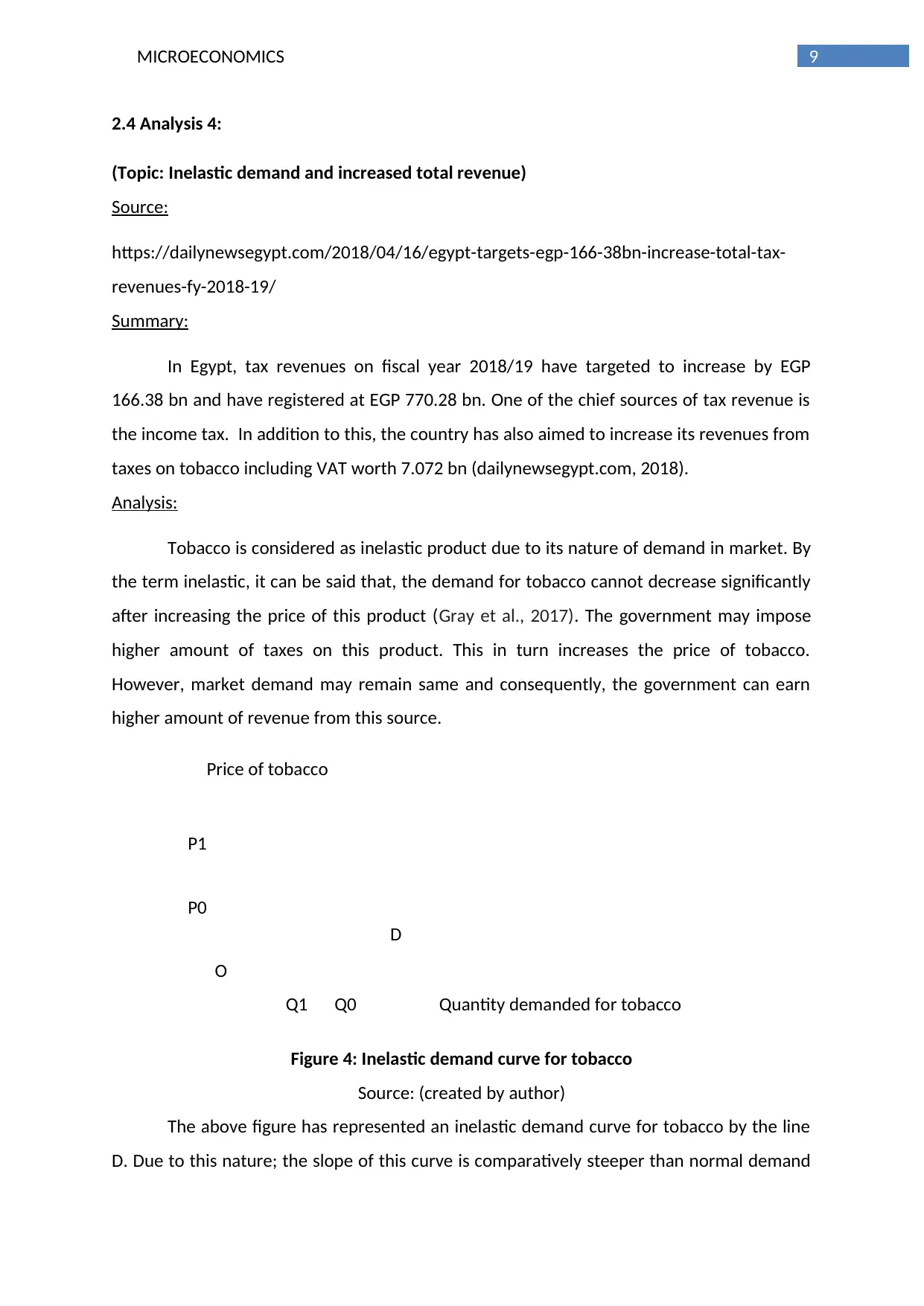
9MICROECONOMICS
Price of tobacco
Quantity demanded for tobacco
O
P1
Q1 Q0
D
P0
2.4 Analysis 4:
(Topic: Inelastic demand and increased total revenue)
Source:
https://dailynewsegypt.com/2018/04/16/egypt-targets-egp-166-38bn-increase-total-tax-
revenues-fy-2018-19/
Summary:
In Egypt, tax revenues on fiscal year 2018/19 have targeted to increase by EGP
166.38 bn and have registered at EGP 770.28 bn. One of the chief sources of tax revenue is
the income tax. In addition to this, the country has also aimed to increase its revenues from
taxes on tobacco including VAT worth 7.072 bn (dailynewsegypt.com, 2018).
Analysis:
Tobacco is considered as inelastic product due to its nature of demand in market. By
the term inelastic, it can be said that, the demand for tobacco cannot decrease significantly
after increasing the price of this product (Gray et al., 2017). The government may impose
higher amount of taxes on this product. This in turn increases the price of tobacco.
However, market demand may remain same and consequently, the government can earn
higher amount of revenue from this source.
Figure 4: Inelastic demand curve for tobacco
Source: (created by author)
The above figure has represented an inelastic demand curve for tobacco by the line
D. Due to this nature; the slope of this curve is comparatively steeper than normal demand
Price of tobacco
Quantity demanded for tobacco
O
P1
Q1 Q0
D
P0
2.4 Analysis 4:
(Topic: Inelastic demand and increased total revenue)
Source:
https://dailynewsegypt.com/2018/04/16/egypt-targets-egp-166-38bn-increase-total-tax-
revenues-fy-2018-19/
Summary:
In Egypt, tax revenues on fiscal year 2018/19 have targeted to increase by EGP
166.38 bn and have registered at EGP 770.28 bn. One of the chief sources of tax revenue is
the income tax. In addition to this, the country has also aimed to increase its revenues from
taxes on tobacco including VAT worth 7.072 bn (dailynewsegypt.com, 2018).
Analysis:
Tobacco is considered as inelastic product due to its nature of demand in market. By
the term inelastic, it can be said that, the demand for tobacco cannot decrease significantly
after increasing the price of this product (Gray et al., 2017). The government may impose
higher amount of taxes on this product. This in turn increases the price of tobacco.
However, market demand may remain same and consequently, the government can earn
higher amount of revenue from this source.
Figure 4: Inelastic demand curve for tobacco
Source: (created by author)
The above figure has represented an inelastic demand curve for tobacco by the line
D. Due to this nature; the slope of this curve is comparatively steeper than normal demand
Paraphrase This Document
Need a fresh take? Get an instant paraphrase of this document with our AI Paraphraser
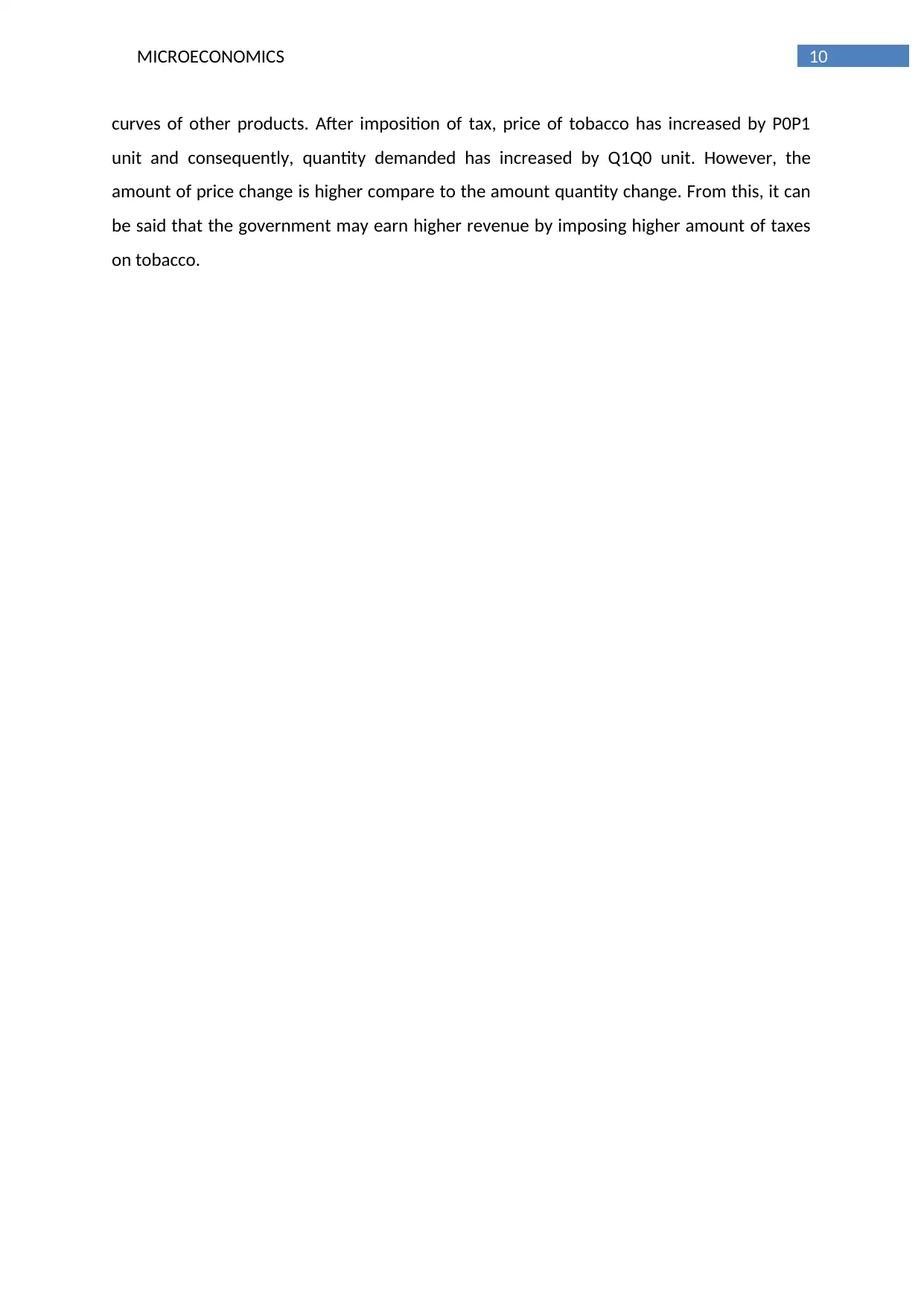
10MICROECONOMICS
curves of other products. After imposition of tax, price of tobacco has increased by P0P1
unit and consequently, quantity demanded has increased by Q1Q0 unit. However, the
amount of price change is higher compare to the amount quantity change. From this, it can
be said that the government may earn higher revenue by imposing higher amount of taxes
on tobacco.
curves of other products. After imposition of tax, price of tobacco has increased by P0P1
unit and consequently, quantity demanded has increased by Q1Q0 unit. However, the
amount of price change is higher compare to the amount quantity change. From this, it can
be said that the government may earn higher revenue by imposing higher amount of taxes
on tobacco.
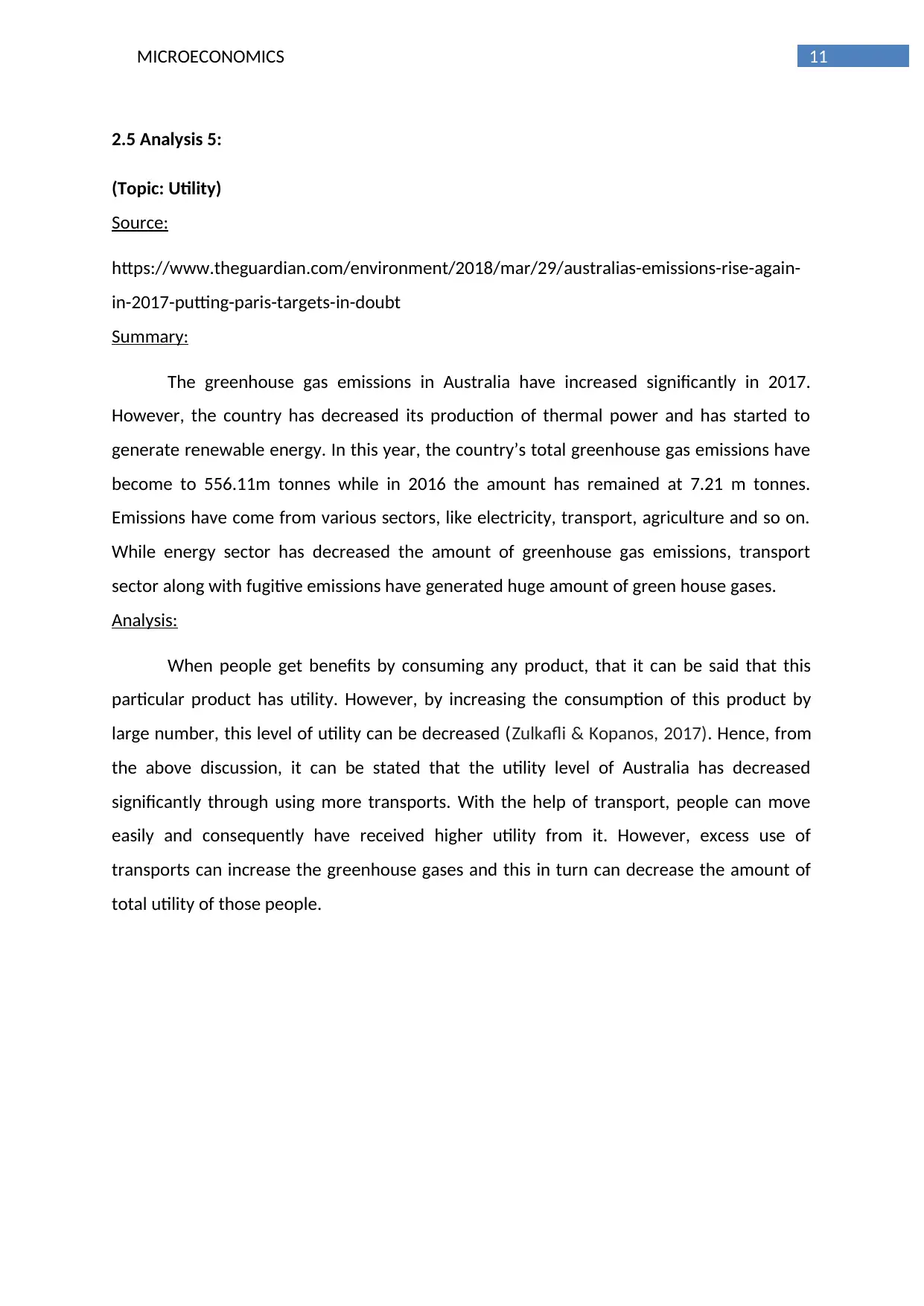
11MICROECONOMICS
2.5 Analysis 5:
(Topic: Utility)
Source:
https://www.theguardian.com/environment/2018/mar/29/australias-emissions-rise-again-
in-2017-putting-paris-targets-in-doubt
Summary:
The greenhouse gas emissions in Australia have increased significantly in 2017.
However, the country has decreased its production of thermal power and has started to
generate renewable energy. In this year, the country’s total greenhouse gas emissions have
become to 556.11m tonnes while in 2016 the amount has remained at 7.21 m tonnes.
Emissions have come from various sectors, like electricity, transport, agriculture and so on.
While energy sector has decreased the amount of greenhouse gas emissions, transport
sector along with fugitive emissions have generated huge amount of green house gases.
Analysis:
When people get benefits by consuming any product, that it can be said that this
particular product has utility. However, by increasing the consumption of this product by
large number, this level of utility can be decreased (Zulkafli & Kopanos, 2017). Hence, from
the above discussion, it can be stated that the utility level of Australia has decreased
significantly through using more transports. With the help of transport, people can move
easily and consequently have received higher utility from it. However, excess use of
transports can increase the greenhouse gases and this in turn can decrease the amount of
total utility of those people.
2.5 Analysis 5:
(Topic: Utility)
Source:
https://www.theguardian.com/environment/2018/mar/29/australias-emissions-rise-again-
in-2017-putting-paris-targets-in-doubt
Summary:
The greenhouse gas emissions in Australia have increased significantly in 2017.
However, the country has decreased its production of thermal power and has started to
generate renewable energy. In this year, the country’s total greenhouse gas emissions have
become to 556.11m tonnes while in 2016 the amount has remained at 7.21 m tonnes.
Emissions have come from various sectors, like electricity, transport, agriculture and so on.
While energy sector has decreased the amount of greenhouse gas emissions, transport
sector along with fugitive emissions have generated huge amount of green house gases.
Analysis:
When people get benefits by consuming any product, that it can be said that this
particular product has utility. However, by increasing the consumption of this product by
large number, this level of utility can be decreased (Zulkafli & Kopanos, 2017). Hence, from
the above discussion, it can be stated that the utility level of Australia has decreased
significantly through using more transports. With the help of transport, people can move
easily and consequently have received higher utility from it. However, excess use of
transports can increase the greenhouse gases and this in turn can decrease the amount of
total utility of those people.
⊘ This is a preview!⊘
Do you want full access?
Subscribe today to unlock all pages.

Trusted by 1+ million students worldwide
1 out of 16
Related Documents
Your All-in-One AI-Powered Toolkit for Academic Success.
+13062052269
info@desklib.com
Available 24*7 on WhatsApp / Email
![[object Object]](/_next/static/media/star-bottom.7253800d.svg)
Unlock your academic potential
Copyright © 2020–2025 A2Z Services. All Rights Reserved. Developed and managed by ZUCOL.





